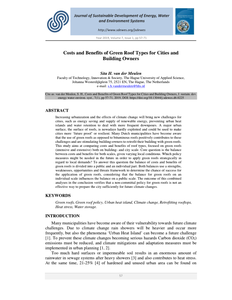Increasing urbanization and the effects of climate change will bring new challenges for cities, such as energy saving and supply of renewable energy, preventing urban heat islands and water retention to deal with more frequent downpours. A major urban surface, the surface of roofs, is nowadays hardly exploited and could be used to make cities more ‘future proof’ or resilient. Many Dutch municipalities have become aware that the use of green roofs as opposed to bituminous roofs positively contributes to these challenges and are stimulating building-owners to retrofit their building with green roofs. This study aims at comparing costs and benefits of roof types, focused on green roofs (intensive and extensive) both on building- and city scale. Core question is the balance between costs and benefits for both scales, given varying local conditions. Which policy measures might be needed in the future in order to apply green roofs strategically in regard to local demands? To answer this question the balance of costs and benefits of green roofs is divided into a public and an individual part. Both balances use a strengths, weaknesses, opportunities and threats framework to determine the chance of success for the application of green roofs, considering that the balance for green roofs on an individual scale influences the balance on a public scale. The outcome of this combined analyses in the conclusion verifies that a responsible policy and a local approach towards green roofs is necessary to prepare the city sufficiently for future climate changes. http://dx.doi.org/10.13044/j.sdewes.d6.0225
MULTIFILE

This paper assesses wind resource characteristics and energy yield for micro wind turbines integrated on noise barriers. An experimental set-up with sonic anemometers placed on top of the barrier in reference positions is realized. The effect on wind speed magnitude, inflow angle and turbulence intensity is analysed. The annual energy yield of a micro wind turbine is estimated and compared using data from a micro-wind turbine wind tunnel experiment and field data. Electrical energy costs are discussed as well as structural integration cost reduction and the potential energy yield could decrease costs. It was found that instantaneous wind direction towards the barrier and the height of observation play an influential role for the results. Wind speed increases in perpendicular flows while decreases in parallel flow, by +35% down to −20% from the reference. The azimuth of the noise barrier expressed in wind field rotation angles was found to be influential resulted in 50%–130% changes with respect to annual energy yield. A micro wind turbine (0.375 kW) would produce between 100 and 600 kWh annually. Finally, cost analysis with cost reductions due to integration and the energy yield changes due to the barrier, show a LCOE reduction at 60%–90% of the reference value. https://doi.org/10.1016/j.jweia.2020.104206
DOCUMENT

From the article: Abstract. This exploratory and conceptual article sets out to research what arguments and possibilities for experimentation in construction exists and if experimentation can contribute towards more innovative construction as a whole. Traditional, -western- construction is very conservative and regional, often following a traditional and linear design process, which focuses on front-loaded cost savings and repetitive efficiency, rather than securing market position through innovation. Thus becoming a hindrance for the development of the sector as a whole. Exploring the effects of using the, in other design-sectors commonly and successfully practiced, “four-phased iterative method” in architectural construction could be the start of transforming the conservative construction industry towards a more innovative construction industry. The goal of this research is to find whether the proposed strategy would indeed result in a higher learning curve and more innovation during the - architectural- process. Preliminary research indicates that there is argumentation for a more experimental approach to construction.
DOCUMENT
